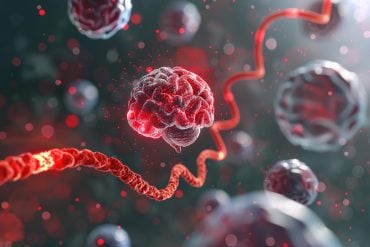Summary: LATE, a form of dementia that appears in the oldest-old is often mistaken for Alzheimer’s disease, but the brain pathology is very different. The protein TDP-43 appears to play a significant role in the development of LATE. The neurodegenerative disease may progress more gradually than Alzheimer’s, but when combined with Alzheimer’s disease (a common combination), appears to cause a more rapid decline than either would alone.
Source: University of Kentucky
In the past, using the terms “Alzheimer’s disease” and “dementia” interchangeably was common. Now there is a rising appreciation that a variety of diseases and disease processes contribute to dementia.
According to Nina Silverberg, Ph.D., director of the Alzheimer’s Disease Centers Program at National Institute on Aging (NIA), part of NIH, in the past many of the people who enrolled in clinical trials for Alzheimer’s drugs likely did not have amyloid — the sticky substance that gums up neurons and interferes with thinking — in their brains.
“Recent research and clinical trials in Alzheimer’s disease have taught us two things: First, not all of the people we thought had Alzheimer’s have it; second, it is very important to understand the other contributors to dementia,” she said.
For years, members of the scientific community have noticed that a large number of people who died in advanced age had symptoms of dementia without the telltale signs of amyloid or another common culprit, tau, in their brains at autopsy. Emerging research seemed to indicate that the protein TDP-43 contributed to that phenomenon.
“More than 200 different viruses can cause the common cold,” said Dr. Peter Nelson of the Sanders-Brown Center on Aging at the University of Kentucky, “So why would we think there is just one cause of dementia?”
A group of international researchers co-chaired by Nelson and Silverberg set out to define diagnostic criteria and other guidelines for advancing future research into this newly-named dementia, called LATE.
LATE, which tends to appear in the oldest-old, may seem the same as Alzheimer’s to the layperson, but the disease inside the brain looks very different. The incidence of LATE is almost as prevalent among the oldest-old as Alzheimer’s.
The group’s work, published on April 30, 2019, in the journal Brain, established that like Alzheimer’s disease, LATE affects multiple areas of cognition, ultimately impairing activities of daily life, but it appears that LATE progresses more gradually than Alzheimer’s. However, LATE combined with Alzheimer’s–which is a common combination–appears to cause a more rapid decline than either would alone.

Nelson likens the committee’s work to Benjamin Franklin’s “discovery” of electricity.
“People had seen lightning before of course, but Franklin helped formalize a concept that augmented our ability to study electricity,” he said. “By developing a sense of scientific focus around these data, we hope to jump-start a broad field of work to advance our understanding of this form of dementia and, ultimately, to open new opportunities for treatment.
Most importantly, Nelson added, it’s time to stop thinking of dementia as a “one-size-fits-all” disease.
“LATE probably responds to different treatments than AD, which might help explain why so many past Alzheimer’s drugs have failed in clinical trials,” he said. “Now that the scientific community is on the same page about LATE, further research into the ‘how’ and ‘why’ can help us develop disease-specific drugs that target the right patients.”
Funding: Funding included grants from NIH: U01AG016976, P01AG003949, R01AG03749, P50AG016574, R01AG054449, P30AG028303, P30AG012300, P30AG049638, P30AG010124, P30AG010161, P50AG047366, P50AG025688, P50AG005131, R37AG011378, R01AG041851, R01AG042210, R01AG017917, R01AG034374, UF1AG053983 and UF1AG057707.
Source:
University of Kentucky
Media Contacts:
Laura Wright – University of Kentucky
Image Source:
The image is in the public domain.
Original Research: Open access
“Limbic-predominant age-related TDP-43 encephalopathy (LATE): consensus working group report “. Peter T Nelson et al. Brain. doi:10.1093/brain/awz099
Abstract
Limbic-predominant age-related TDP-43 encephalopathy (LATE): consensus working group report
We describe a recently recognized disease entity, limbic-predominant age-related TDP-43 encephalopathy (LATE). LATE neuropathological change (LATE-NC) is defined by a stereotypical TDP-43 proteinopathy in older adults, with or without coexisting hippocampal sclerosis pathology. LATE-NC is a common TDP-43 proteinopathy, associated with an amnestic dementia syndrome that mimicked Alzheimer’s-type dementia in retrospective autopsy studies. LATE is distinguished from frontotemporal lobar degeneration with TDP-43 pathology based on its epidemiology (LATE generally affects older subjects), and relatively restricted neuroanatomical distribution of TDP-43 proteinopathy. In community-based autopsy cohorts, ∼25% of brains had sufficient burden of LATE-NC to be associated with discernible cognitive impairment. Many subjects with LATE-NC have comorbid brain pathologies, often including amyloid-β plaques and tauopathy. Given that the ‘oldest-old’ are at greatest risk for LATE-NC, and subjects of advanced age constitute a rapidly growing demographic group in many countries, LATE has an expanding but under-recognized impact on public health. For these reasons, a working group was convened to develop diagnostic criteria for LATE, aiming both to stimulate research and to promote awareness of this pathway to dementia. We report consensus-based recommendations including guidelines for diagnosis and staging of LATE-NC. For routine autopsy workup of LATE-NC, an anatomically-based preliminary staging scheme is proposed with TDP-43 immunohistochemistry on tissue from three brain areas, reflecting a hierarchical pattern of brain involvement: amygdala, hippocampus, and middle frontal gyrus. LATE-NC appears to affect the medial temporal lobe structures preferentially, but other areas also are impacted. Neuroimaging studies demonstrated that subjects with LATE-NC also had atrophy in the medial temporal lobes, frontal cortex, and other brain regions. Genetic studies have thus far indicated five genes with risk alleles for LATE-NC: GRN, TMEM106B, ABCC9, KCNMB2, and APOE. The discovery of these genetic risk variants indicate that LATE shares pathogenetic mechanisms with both frontotemporal lobar degeneration and Alzheimer’s disease, but also suggests disease-specific underlying mechanisms. Large gaps remain in our understanding of LATE. For advances in prevention, diagnosis, and treatment, there is an urgent need for research focused on LATE, including in vitro and animal models. An obstacle to clinical progress is lack of diagnostic tools, such as biofluid or neuroimaging biomarkers, for ante-mortem detection of LATE. Development of a disease biomarker would augment observational studies seeking to further define the risk factors, natural history, and clinical features of LATE, as well as eventual subject recruitment for targeted therapies in clinical trials.






